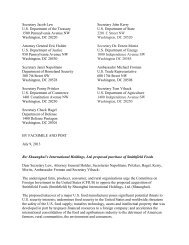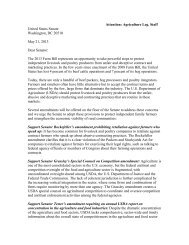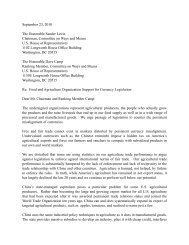Exhibit 8, 100416 Brazil FMD Risk Evaluation - R-Calf
Exhibit 8, 100416 Brazil FMD Risk Evaluation - R-Calf
Exhibit 8, 100416 Brazil FMD Risk Evaluation - R-Calf
You also want an ePaper? Increase the reach of your titles
YUMPU automatically turns print PDFs into web optimized ePapers that Google loves.
Annex 4. Hazard Identification: African Swine Fever Disease Virus<br />
African swine fever (ASF) is a highly contagious, frequently fatal, and economically damaging viral<br />
disease of pigs. As specified in 9 CFR 94.8, APHIS believes that ASF exists in all countries of<br />
Africa, as well as in <strong>Brazil</strong>, Cuba, Georgia, Haiti, Malta, and Sardinia, one of Italy’s islands. ASF<br />
has never been reported in the United States [78]. Natural hosts of ASF virus are members of the<br />
suidae family of mammals, including domestic and wild swine [30, 79].<br />
In sub-Saharan Africa, ASF is maintained in the wild through a life cycle including wild suidae and<br />
soft-bodied ticks (Ortnithodoros sp.)[80]. The disease is primarily spread into previously uninfected<br />
areas through feeding improperly cooked swill containing ASFV to domestic swine. The virus is<br />
generally spread among domestic pigs by direct or indirect contact [80]. The virus is present in all<br />
secretions and excretions, including blood and oral and nasal secretions, and may be spread through<br />
semen [79]. Virus is often shed before the onset of clinical signs in acute and subacute disease [81].<br />
The incubation period following exposure via direct contact is 5 to 19 days, while the incubation<br />
period following tick exposure may be fewer than 5 days. Depending on the virulence of the strain,<br />
ASF can manifest as percute, acute, subacute, chronic, or even inapparent disease. The peracute<br />
form generally causes sudden death. In the acute form, pigs display a multitude of clinical signs,<br />
ranging from cyanosis and dyspnea to diarrhea. Nearly all body systems are affected. Death<br />
generally follows in 7 to 10 days.<br />
The signs of subacute ASF are similar to those of the acute disease, but are less severe. Low virulent<br />
viral strains can cause inapparent, mild, or chronic infections. Abortion may be the only clinical<br />
sign, but intermittent fevers, emaciation, respiratory problems, swollen joints, skin lesions and<br />
potentially death may occur [80].<br />
The ASF virus is stable across a wide temperature and pH range [79]. The virus has been shown to<br />
survive in chilled or frozen pork for 104 days. The virus has also been shown to survive for at least<br />
some period at pHs ranging from 3.1 to 11.5. Pork generally reaches a pH of 5.4-5.5 following<br />
carcass maturation, but this varies depending on the specific carcass and the temperature. The virus<br />
can often survive processes such as curing and salting. Farez and Morley conducted a literature<br />
review and reported survival times ranging from 30 days in salami to 399 days in Parma ham [82].<br />
APHIS <strong>Evaluation</strong> of the Status of the <strong>Brazil</strong>ian State of Santa Catarina 76











